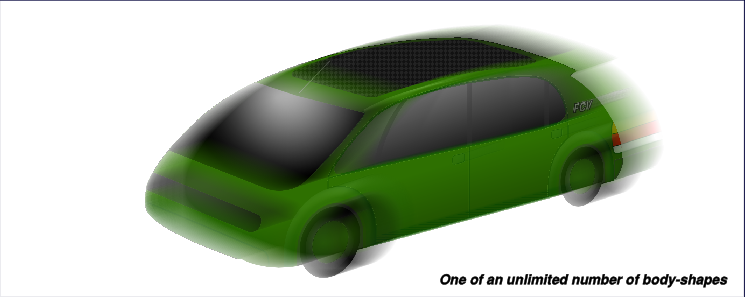






Design of logos and design and name of cars and logos copyright 1996-2006 Nobilangelo Ceramalus & EStarFuture Corporation Limited

C

A mockup of a six-wheel version of the E*Car. Because the motors are in the wheels, adding two wheels to a car of the same size adds 33% more power & torque.


Zero Emissions (just pure water)
Six-wheeler design below...


A mockup of a super-stretch sixteen-wheel version of the EStarCar.
Overwhelming sixteen-wheel power and torque, and sixteen-wheel EStar drive-by-wire steering.
Overwhelming sixteen-wheel power and torque, and sixteen-wheel EStar drive-by-wire steering.


INVESTORS WANTED
$NZ600,000 (~$US390,000) is needed to take the EStarCar from where it is now--its CAD stage--through to tested prototypes and the start of production. Maximum two years.
$NZ600,000 (~$US390,000) is needed to take the EStarCar from where it is now--its CAD stage--through to tested prototypes and the start of production. Maximum two years.
Overview of the EStarCar (TM)
Length 4 metres (full length usable internally); dry-weight 1250kg; capacity, 8 people and luggage;
all-electric; an FCV+ (i.e., an FCV with multiple power-sources); in-wheel motors; peak torque 703.5Nm (for a four-wheel EStarCar--far more than either the Toyota Prius, which peaks at 111Nm from its engine and 400Nm from its electric motor, or GM's V8 Holden Commodore which peaks at 470Nm);
acceleration, 0-100kph in 10.4 seconds; range without a fuel-cell >250km, with a fuel-cell, >500km;
all-alloy construction (low weight, strong, recyclable); all-wheel drive; all-wheel steering; independent suspension; anti-lock brakes; physically and logically configurable internally and externally; any car, van, pickup, etc., body with matching interface can be fitted to the chassis; bodies quickly interchangeable; extendible chassis; the 12 primary and secondary power-sources include fuel-cell, LiPo batteries, ultracapacitors, rooftop solar-cells, regenerative braking; the 10 primary sources generate on the move, adding range; low centre-of-gravity and wide track for stability and safety; quiet, unslammable doors; low-cost design; low-cost prototype and start-up; low-cost, dispersed, infinitely-scalable production;
projected price $NZ100,000 for pre-volume production, $NZ25,000 for volume-production.
Length 4 metres (full length usable internally); dry-weight 1250kg; capacity, 8 people and luggage;
all-electric; an FCV+ (i.e., an FCV with multiple power-sources); in-wheel motors; peak torque 703.5Nm (for a four-wheel EStarCar--far more than either the Toyota Prius, which peaks at 111Nm from its engine and 400Nm from its electric motor, or GM's V8 Holden Commodore which peaks at 470Nm);
acceleration, 0-100kph in 10.4 seconds; range without a fuel-cell >250km, with a fuel-cell, >500km;
all-alloy construction (low weight, strong, recyclable); all-wheel drive; all-wheel steering; independent suspension; anti-lock brakes; physically and logically configurable internally and externally; any car, van, pickup, etc., body with matching interface can be fitted to the chassis; bodies quickly interchangeable; extendible chassis; the 12 primary and secondary power-sources include fuel-cell, LiPo batteries, ultracapacitors, rooftop solar-cells, regenerative braking; the 10 primary sources generate on the move, adding range; low centre-of-gravity and wide track for stability and safety; quiet, unslammable doors; low-cost design; low-cost prototype and start-up; low-cost, dispersed, infinitely-scalable production;
projected price $NZ100,000 for pre-volume production, $NZ25,000 for volume-production.






